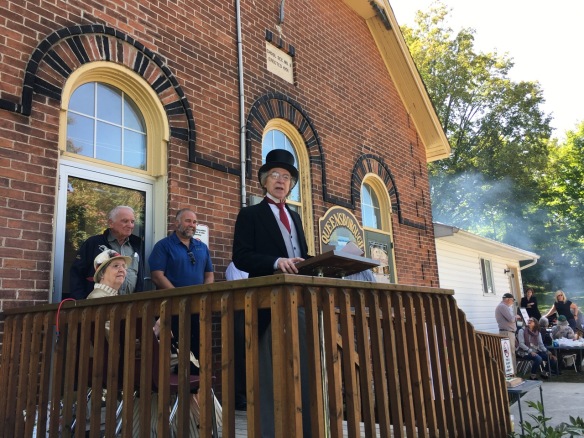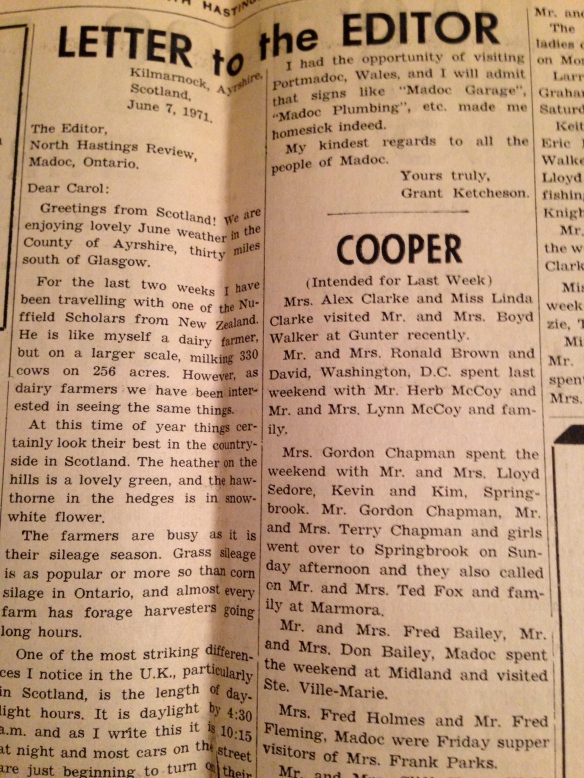
Happy Easter from the Manse! This is Raymond and me celebrating our wedding anniversary this Easter Sunday and modelling the rather cute face masks that our friend Eliza was kind enough to make for us. Love in the time of Covid…
Happy Easter/Passover/long weekend, everyone! Today I’d like to tell you a story about kindness and neighbourliness in a time of trouble, which of course would be now. I hope it’ll brighten your spirits if this day has you feeling lonely or sad because of the need to stay away from friends and loved ones. As you might guess, my story is Queensborough-themed (with a fair bit of Bannockburn thrown in – stay with me and you’ll learn what that means, if you don’t already know). In my opinion, that makes it all the better.
My story starts with a social-media post by my friend Eliza Deary, a stonemason, local-history enthusiast and mom (among quite a few other accomplishments). I met Eliza a few years ago during the battle to save our local elementary school, a fight that was ultimately successful thanks in large part to committed parents and community members like her. It was Eliza who told me the story of how she had moved her family to our area (where she originally comes from) because a smart teacher had suggested that the small size and one-on-one attention to students’ needs at Madoc Township Public School might benefit Eliza’s son Isaac, who was struggling a bit in a large city school. Isaac’s story had an amazing ending; with the support he received at our wonderful little school, he zoomed up to his grade level in all subjects in a matter of months. You can read the whole story here.
Anyway: the battle for Madoc Township Public School won, we move on to the spring of 2020 and the coronavirus crisis that we’re all living through.
A couple of weeks ago, as the seriousness of the threat from the virus became more and more evident, and medical advice shifted from “You don’t need to wear a mask – save them for the health workers” to “Oops – maybe everyone should wear a mask when out in public,” I found myself wishing I had a source for masks for Raymond and me. Pharmacies were long since sold out, of course. Instructions for sewing masks were making the rounds of the internet, but I’m afraid that, despite the best efforts of my home-ec teachers at Centre Hastings Secondary School in the 1970s and my 4-H Club leaders here in Queensborough in the same era, I have zero sewing skills plus what naturally goes with that, zero sewing equipment.
Then I saw a Facebook post from Eliza about masks she and her kids had sewed, and a followup comment from someone saying there were probably people in the community who would be happy to pay her to make masks for them.
Bingo!
I messaged Eliza, and four masks – two size medium for me and two size large for Raymond – were ready for pickup from Eliza’s mailbox the very next day. I should note that Eliza’s mailbox, like Eliza’s home, is in the Madoc Township hamlet of Bannockburn – hence my reference at the top of this post. The trip to Bannockburn from Queensborough is a pleasant five-mile drive north up Barry Road to another hamlet, Cooper, and then west along Bannockburn Road four more miles to where it intersects with Highway 62 in “downtown” Bannockburn. Eliza only wanted to charge me $5 per mask, but it was worth at least double that to me and that’s what I paid her – by online transfer, of course, since that’s how we roll in these Covid times.
A couple of days later, I got a message from a Queensborough friend, Jessica, who is a nurse:
Hi Katherine. I’m reaching out to you today to ask if you know anyone in our community that sews. I’m working in Bancroft hospital in the ER. As you can imagine we are nervous … If you could in any way ask some community members or church members or friends or family who are willing to sew head covers – headbands with buttons to hook earloop masks on – or even masks of any kind, the staff at Bancroft would be endlessly grateful. I felt you would be the person to reach out to as you have a connection to so many people! Thanks for considering this and thank you for all your work you do for our community.
Well! You can imagine who came immediately to mind. Within a couple of minutes of getting Jessica’s message I’d not only forwarded it on to Eliza, but received an enthusiastic response from her:
I will happily help out front-line staff. I have plenty of fabric, a couple of machines and helpers, so I could easily sew quite a bit. What I have less of is buttons and elastic or other material to make ties with – ribbons, laces and the like … I am happy to help any way I can.
Wow!
Jessica was thrilled. “Oh my goodness – this is incredible!” she wrote. She sent a mask pattern that had been approved by the hospital, offered up buttons and other materials, and Eliza and her household got to work:

The pleats that allow the mask to be expanded, neatly pinned for sewing. Photo courtesy of Eliza Deary
Meanwhile, I wrote a post on the Queensborough Community Centre’s Facebook page about this neighbours-helping-neighbours project, asking if anyone could donate the elastic and wire that Eliza needed to make the preferred kind of masks. The response was swift, and big. My phone rang, the post got shared around to hundreds of people, and very shortly I had offers of both elastic and craft wire.
The elastic came from my Cooper friend Jean Finlayson, a hugely talented painter and fabric artist. She had two GIGANTIC spools of elastic she was happy to donate to the cause. Raymond and I took another drive up Barry Road and collected it, along with a catnip-filled cat toy that Jean had made for our rather large collection of Manse cats. Here’s me and Jean as I pick up the elastic and toy from her front porch:
And here’s a closeup of the toy plus the newest addition to the Manse-cat family, Mama Cass, enjoying it:
Then I got a message from Caroline, someone whom I’ve not yet met, a newish arrival to Queensborough:
I saw your message about gathering supplies for masks. I don’t have elastic but do have a spool or two of 24 gauge craft wire in my jewelry making supplies. I’m happy to part with it, if it can be of use.
And shortly thereafter, the wire appeared in my mailbox …
… and Raymond and I were taking another drive up Barry Road to Bannockburn. This time not only were we delivering the wire for the masks but also picking up two more masks that Eliza had kindly made for another newish Queensborough resident who’d contacted me to ask where she might be able to get some.
Eliza and her home crew have so far made close to 50 masks for the Bancroft ER staff, and they’re still working. They’re getting headbands done too. She could use more volunteers to help with the sewing, and if that might be you, please leave a message here or email me (sedgwick.katherine@gmail.com).
Meanwhile, Jessica has sent me these wonderful photos of herself and her colleagues wearing Eliza’s masks:

That’s Jessica on the right, with a happy grin as she models one of Eliza’s masks at work in the Bancroft hospital’s emergency room. Photo courtesy of Jessica Lyon
And this simple note:
Everyone says thank you so much from the bottom of our hearts!
I cannot tell you how happy these photos make me. Jessica and her colleagues are out there on the front lines of an unprecedented health crisis. They work long hours dealing with potentially terrifying situations, and then they go home to their families, praying they’re still healthy. As I carry on my own job from the safety of the Manse in Queensborough, I am thankful for what Jessica and so many others are doing for all of us.
And I am so thankful for people like Eliza, Jean, Caroline and all the others who’ve spearheaded and supported this mask project to support Jessica and her colleagues. This is kindness in action – and rural life at its best.

























































